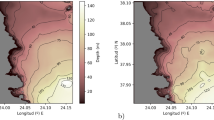Abstract
Satellite image sequences visualise the ocean surface and allow assessing its dynamics. Processing these data is then of major interest to get a better understanding of the observed processes. As demonstrated by state-of-the-art, image assimilation permits to retrieve surface motion, based on assumptions on the dynamics. In this paper, we demonstrate that a simple heuristics, such as the Lagrangian constancy of velocity, can be used and successfully replaces the complex physical properties described by the Navier-Stokes equations for assessing surface circulation from satellite images. A data assimilation method is proposed that adds an acceleration term \(\mathbf {a}(t)\) to this Lagrangian constancy equation, which summarises all physical processes other than advection. A cost function is designed that quantifies discrepancy between satellite data and model values. This cost function is minimised by the BFGS solver with a dual method of data assimilation. The result is the initial motion field and the acceleration terms \(\mathbf {a}(t)\) on the whole temporal interval. These values \(\mathbf {a}(t)\) model the forces, other than advection, that contribute to surface circulation. Our approach was tested on synthetic data and with Sea Surface Temperature images acquired on Black Sea. Results are quantified and compared to those of state-of-the-art methods.
Similar content being viewed by others
Notes
References
Byrd, R.H., Lu, P., Nocedal, J.: A limited memory algorithm for bound constrained optimization. J. Sci. Stat. Comput. 16(5), 1190–1208 (1995)
Dee, D.: Bias and data assimilation. Q. J. R. Meteorol. Soc. 131, 3323–3343 (2005)
Hascoët, L., Pascual, V.: The tapenade automatic differentiation tool: principles, model, and specification. ACM Trans. Math. Softw. 39(3), 20 (2013)
Hundsdorfer, W., Spee, E.: An efficient horizontal advection scheme for the modeling of global transport of constituents. Mon. Weather Rev. 123(12), 3554–3564 (1995)
Huot, E., Herlin, I., Mercier, N., Plotnikov, E.: Estimating apparent motion on satellite acquisitions with a physical dynamic model. In: International Conference on Image Processing, pp. 41–44, August 2010
Korotaev, G.K., Huot, E., Le Dimet, F.X., Herlin, I., Stanichny, S.V., Solovyev, D.M., Wu, L.: Retrieving ocean surface current by 4-D variational assimilation of sea surface temperature images. Remote Sens. Environ. 112(4), 1464–1475 (2008) (special issue on data assimilation)
Le Dimet, F., Talagrand, O.: Variational algorithms for analysis and assimilation of meteorological observations: theoretical aspects. Tellus 97–110 (1986)
LeVeque, R.: Numerical Methods for Conservative Laws, 2nd edn. Lectures in Mathematics. ETH Zürich, Birkhaüser Verlag (1992)
Lions, J.L.: Optimal Control of Systems Governed by Partial Differential Equations. Springer, Berlin (1971)
Oguz, T., La Violette, P., Unluata, U.: The upper layer circulation of the Black Sea: its variability as inferred from hydrographic and satellite observations. J. Geophys. Res. 78(8), 12569–12584 (1992)
Papadakis, N., Corpetti, T., Mémin, E.: Dynamically consistent optical flow estimation. In: Proceedings of International Conference on Computer Vision. Rio de Janeiro, Brazil (2007)
Sasaki, Y.: Some basic formalisms in numerical varational analysis. Mon. Weather Rev. 98(12), 875–883 (1970)
Sun, D., Roth, S., Black, M.: Secrets of optical flow estimation and their principles. In: Proceedings of European Conference on Computer Vision, pp. 2432–2439 (2010)
Suter, D.: Motion estimation and vector splines. In: Proceedings of Conference on Computer Vision and Pattern Recognition, pp. 939–942 (1994)
Titaud, O., Vidard, A., Souopgui, I., Le Dimet, F.X.: Assimilation of image sequences in numerical models. Tellus A 62, 30–47 (2010)
Trémolet, Y.: Accounting for an imperfect model in 4D-Var. Q. J. R. Meteorol. Soc. 132(621), 2483–2504 (2006)
Vallis, G.K.: Atmospheric and Oceanic Fluid Dynamics, p. 745. Cambridge University Press, Cambridge (2006)
Valur Hólm, E.: Lectures notes on assimilation algorithms. Technical report, European Centre for Medium-Range Weather Forecasts Reading, UK (2008)
Wolke, R., Knoth, O.: Implicit-explicit Runge-Kutta methods applied to atmospheric chemistry-transport modelling. Environ. Model. Softw. 15, 711–719 (2000)
Zhu, C., Byrd, R., Lu, P., Nocedal, J.: L-BFGS-B: Algorithm 778: L-BFGS-B, FORTRAN routines for large scale bound constrained optimization. ACM Trans. Math. Softw. 23(4), 550–560 (1997)
Acknowledgements
Data have been provided by E. Plotnikov and G. Korotaev from the Marine Hydrophysical Institute of Sevastopol, Ukraine.
Author information
Authors and Affiliations
Corresponding author
Editor information
Editors and Affiliations
Rights and permissions
Copyright information
© 2015 Springer International Publishing Switzerland
About this paper
Cite this paper
Béréziat, D., Herlin, I. (2015). Coupling Dynamic Equations and Satellite Images for Modelling Ocean Surface Circulation. In: Battiato, S., Coquillart, S., Pettré, J., Laramee, R., Kerren, A., Braz, J. (eds) Computer Vision, Imaging and Computer Graphics - Theory and Applications. VISIGRAPP 2014. Communications in Computer and Information Science, vol 550. Springer, Cham. https://doi.org/10.1007/978-3-319-25117-2_12
Download citation
DOI: https://doi.org/10.1007/978-3-319-25117-2_12
Published:
Publisher Name: Springer, Cham
Print ISBN: 978-3-319-25116-5
Online ISBN: 978-3-319-25117-2
eBook Packages: Computer ScienceComputer Science (R0)




